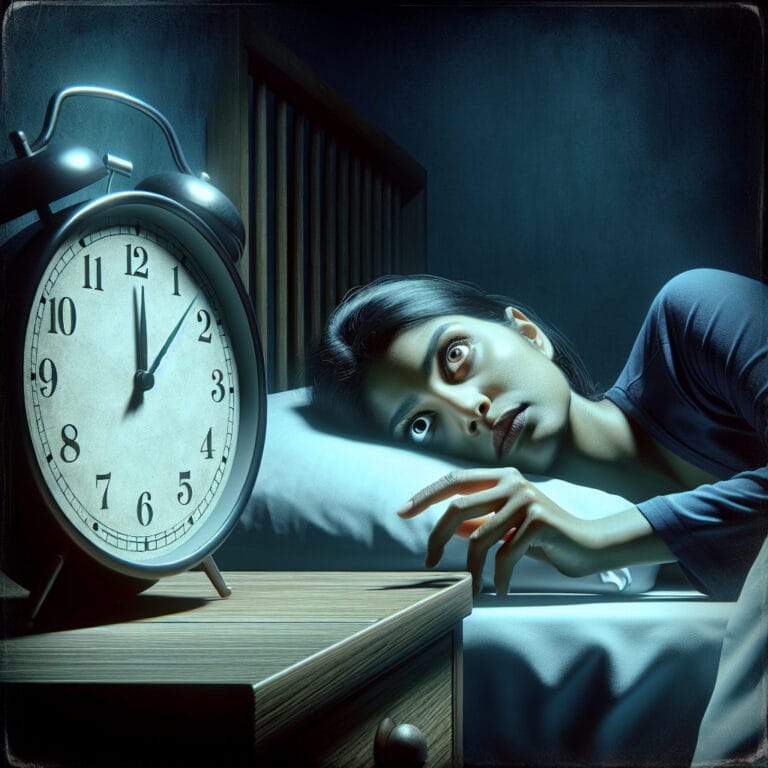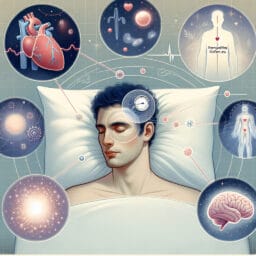
Understanding the Concept: What Does ‘Sleep Latency’ Mean?
Table of Contents
- Introduction
- The Science Behind Sleep Latency
- The Impact of Sleep Latency on Health
- How to Measure Sleep Latency
- Conclusion
- Frequently Asked Questions
Introduction
A surprising fact is that sleep latency, the time it takes for you to transition from full wakefulness to sleep, plays a significant role in your overall health. When we speak about falling asleep, it’s not simply an on-off switch but rather a progression through different stages of sleep – from light non-rapid eye movement (NREM) sleep to deep NREM followed by rapid eye movement (REM) phase. Understanding this shift and its timing can provide insights into various aspects of your wellbeing. Long sleep latency might indicate issues such as chronic insomnia or other central disorders of hypersomnia, which could significantly affect your total sleep time and quality.
Excessive daytime sleepiness or an increased risk of mood disturbances may result from insufficient rest caused by longer-than-normal latency periods. On the other hand, excessively short latency could be symptomatic of conditions like narcolepsy. A multiple sleep latency test (MSLT), often conducted in a specialized sleep laboratory following an overnight study can help evaluate these aspects accurately. The MSLT essentially includes multiple nap trials with evaluations measuring how quickly you fall asleep and reach REM stage.
Circadian rhythm also links closely with this process; disruption in our internal biological clock can indeed increase the time taken to enter REM – impacting both our efficiency and hygiene of slumber. Therefore, understanding our personal ‘sleep onset’ story holds importance: it helps us maintain good habits, spot potential disorders early on and ensure we are fully rested – all vital for sustaining optimal health.
The Science Behind Sleep Latency
Diving deeper into the different stages of sleep reveals a close association with sleep latency. Our night is typically divided into NREM (Non-Rapid Eye Movement) and REM (Rapid Eye Movement) sleep, both of which alternate cyclically throughout our rest period. The NREM phase initially dominates, encompassing light sleep where we transition from full wakefulness to slumber, and gradually moves to deep sleep characterized by slower brain waves. As we advance through the night, the proportion of REM stage increases – this is when we dream and experience increased brain activity similar to that seen in a fully awake state.
Now, what’s intriguing about these diverse phases is their correlation with sleep latency. Essentially, if it takes longer for us to fall asleep after lying down – known as long sleep latency – it disruptively elongates this transition phase into deep or REM stage. Circadian rhythm also plays a vital role here; any misalignment in our internal biological clock can delay entering REM sleep which consequently impacts both total sleep time and quality.
Various factors can influence your personal ‘sleep onset’ story: lifestyle habits such as physical exercise or caffeine intake, environmental parameters like room temperature or noise level, psychological elements including stress or anxiety levels—all these have potential impacts on how quickly you drift off each night. It’s crucial to maintain good sleeping habits and ensure optimal conditions for uninterrupted rest – often termed as maintaining proper ‘sleep hygiene’.
For those struggling with atypical patterns such as chronic insomnia or excessive daytime sleepiness – indicative of delayed or shortened latency respectively – specialized tests like multiple Sleep Latency Test (MSLT) are available. Conducted in an overnight study at a certified Sleep Laboratory under expert supervision by a qualified Sleep Doctor, these evaluations include nap trials measuring your ability to stay awake during day time scenarios following regular intervals along with wakefulness tests assessing your readiness for transitioning towards various stages of NREM & REM periods post bedtime.
Having a clear understanding of these factors can significantly affect your sleep health, helping you identify issues and adjust routines to get the restful, rejuvenating sleep that we all need.
| Topic | Description |
|---|---|
| NREM Sleep | Non-Rapid Eye Movement sleep, initially dominates the sleep cycle, transitioning from wakefulness to slumber and gradually moving to deep sleep characterized by slower brain waves. |
| REM Sleep | Rapid Eye Movement sleep, increases proportionally through the night, characterized by dreaming and increased brain activity similar to being fully awake. |
| Sleep Latency | The time it takes to fall asleep after lying down. Longer sleep latency disrupts the transition into deep or REM sleep. |
| Circadian Rhythm | The body’s internal biological clock. Misalignment can delay REM sleep and impact total sleep time and quality. |
| Influencing Factors | Physical exercise, caffeine intake, room temperature, noise level, stress, anxiety can all impact sleep latency. |
| Sleep Hygiene | Refers to maintaining good sleeping habits and optimal conditions for uninterrupted sleep. |
| Atypical Sleep Patterns | Conditions like chronic insomnia or excessive daytime sleepiness, indicative of delayed or shortened sleep latency. |
| Sleep Latency Test (MSLT) | Specialized tests conducted at a Sleep Laboratory under expert supervision to measure ability to stay awake and readiness for transitioning towards NREM & REM sleep. |
The Impact of Sleep Latency on Health
Shedding light on the correlation between sleep latency and physical health, a longer sleep latency can often indicate disruptions in our optimal rest patterns. The impact is not just confined to feeling drowsy or groggy; it significantly affects overall bodily functions and wellness. For instance, chronic insomnia, characterized by prolonged periods of staying awake despite efforts to fall asleep, can be linked to cardiovascular issues, obesity and even increased risk of type 2 diabetes. On the other end of spectrum lies narcolepsy. It’s marked by extreme drowsiness during daytime and falling asleep suddenly without warning – a sign of extremely short sleep latency – leading to safety concerns especially when engaging in activities like driving or operating heavy machinery.
A compelling connection also exists between sleep latency and mental health. Just as insufficient sleep impair cognitive performance with slow reaction times or difficulty focusing, it also has psychological repercussions. Extended wakefulness test results from an overnight study at a certified Sleep Laboratory might reveal depressive symptoms among individuals experiencing long sleep latency, manifesting through feelings of sadness or loss of pleasure in activities once enjoyed. Conversely, frequent episodes of REM stage intrusions into wakefulness—often detected via Multiple Sleep Latency Test (MSLT)—could signal underlying anxiety disorders where patients experience intrusive thoughts that prevent them from entering deep NREM stages required for restful slumber.
How to Measure Sleep Latency
While falling asleep may seem like a simple transition from wakefulness to sleep, the actual process involves a well-orchestrated symphony of sleep stages guided by our circadian rhythm. One paramount metric in understanding this dance is ‘sleep latency’, or the time it takes for you to fall asleep once you’re in bed. Assessing this can offer key insights into your sleep cycle, and quite possibly unveil hidden sleep disorders that might be hampering your overall health. A useful tool for measuring sleep latency is the Multiple Sleep Latency Test (MSLT). It’s an intensive daytime nap trial conducted after an overnight sleep study at a specialized Sleep Laboratory, under the watchful eye of a trained Sleep Doctor who monitors when and how swiftly one enters REM stage post bedtime.
This MSLT test becomes instrumental in diagnosing narcolepsy or central disorders affecting hypersomnia where these latency values are significantly shorter than normal, or chronic insomnia marked by longer periods of staying awake despite efforts taken to drift off. However, not all evaluations need heavy medical machinery; sometimes maintaining a regular ‘Sleep Diary’ can offer valuable data about your sleeping habits too. By recording details such as total recording time asleep versus time spent in bed trying to fall asleep provides crucial information on long sleep latency aiding early detection of possible issues like excessive daytime sleepiness or other disturbances impacting total quality and efficiency of rest.
| Term | Description |
|---|---|
| Sleep Latency | The time it takes for you to fall asleep once you’re in bed. |
| Multiple Sleep Latency Test (MSLT) | A daytime nap trial conducted after an overnight sleep study in a specialized Sleep Laboratory. It is used to measure the speed of entering REM stage post bedtime. |
| Narcolepsy | A neurological disorder that affects the control of sleep and wakefulness. People with narcolepsy experience excessive daytime sleepiness and intermittent, uncontrollable episodes of falling asleep during the daytime. |
| Central Disorders Affecting Hypersomnia | Disorders that result in excessive sleepiness, usually caused by problems in the central nervous system. In these cases, sleep latency values are significantly shorter than normal. |
| Chronic Insomnia | A sleep disorder characterized by difficulties falling and/or staying asleep. It is marked by longer periods of staying awake despite efforts taken to drift off. |
| Sleep Diary | A tool for recording details such as total time spent asleep versus time spent in bed trying to fall asleep. It provides crucial information on sleep latency and can aid in the early detection of possible sleep issues. |
| Excessive Daytime Sleepiness | A symptom of several sleep disorders, characterized by persistent sleepiness and often a general lack of energy, even during the day after apparently adequate or even prolonged nighttime sleep. |
Conclusion
Unraveling the secret of a restorative night’s sleep reveals the crucial role played by ‘sleep latency’—the timeframe that transitions us from wakefulness to slumber. This integral phase, impacting both our total sleep time and overall sleep efficiency, is influenced by an array of factors ranging from circadian rhythm to lifestyle habits. Consequently, observing abnormal patterns in your sleep latency could be a harbinger of potential disorders. For instance, if you’re spending long periods trying to fall asleep or staying awake despite fatigue, it may suggest chronic insomnia. Conversely, falling asleep abruptly with little warning could indicate narcolepsy or central disorders affecting hypersomnia. Understanding your personal ‘sleep onset’ story is expedited by monitoring tools like a sleep diary or professional assessments such as multiple sleep latency test (MSLT) and wakefulness test (MWT)—conducted in a dedicated Sleep Laboratory under expert supervision of trained specialists in Sleep Medicine. These evaluations gauge how quickly you drift off and reach Rapid Eye Movement (REM) stage—the dream phase characterized by similar brain activity as when fully awake—and provide substantial insights into your unique sleeping habits. Thus, demystifying your journey through different stages from NREM to REM plays an instrumental role in fostering good ‘sleep hygiene’, managing excessive daytime sleepiness and maintaining optimal health—a gift truly worth losing some sleep over!

